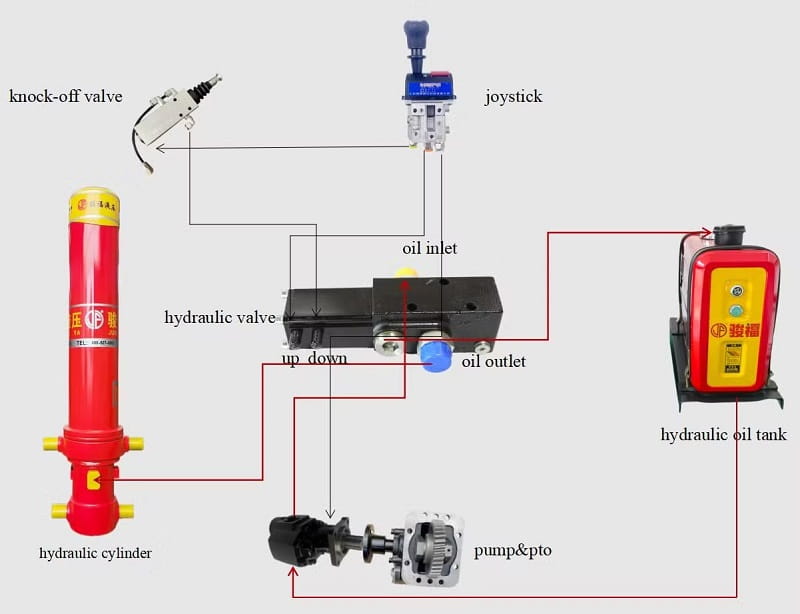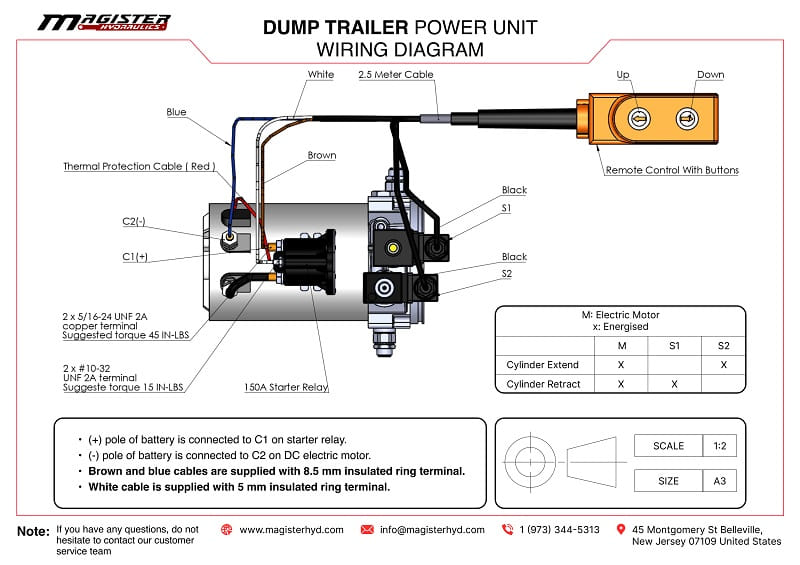Understanding the Dump Truck Hydraulic System Schematic: Components, Functionality, and Maintenance catdumptruck.com | A dump truck is a crucial vehicle in industries such as construction, mining, and transportation. The hydraulic system is the backbone of its operation, enabling the lifting and lowering of the dump bed efficiently.
Understanding the schematic of a dump truck hydraulic system is essential for operators, mechanics, and engineers to ensure smooth functionality and troubleshoot potential issues.
This article provides a detailed overview of the hydraulic system schematic, its components, functionality, and maintenance tips to keep the system operating at peak efficiency.
Read More: Understanding the Dump Truck Hydraulic Tank: Functions, Components, and Maintenance
What is a Dump Truck Hydraulic System Schematic?

A dump truck hydraulic system schematic is a visual representation of the hydraulic components and their connections.
It helps in understanding how hydraulic power is generated, distributed, and controlled within the system. The schematic typically includes symbols representing hydraulic pumps, valves, cylinders, reservoirs, filters, and hoses.
By studying the schematic, operators and maintenance personnel can diagnose problems, perform repairs, and optimize performance efficiently.
Key Components of a Hydraulic System
A dump truck hydraulic system consists of several essential components that work together to provide lifting force and controlled movement. These include:
Hydraulic Tank (Reservoir)
Stores and supplies hydraulic fluid to the system.
Ensures proper cooling, filtration, and air removal from the fluid.
Hydraulic Pump
Converts mechanical power from the truck’s engine or transmission into hydraulic energy.
Creates the necessary pressure to drive the hydraulic cylinder.
Control Valve
Directs the flow of hydraulic fluid to the cylinder.
Typically consists of a lever-operated or electronically controlled mechanism.
Hydraulic Cylinder
The primary actuator that extends and retracts to lift and lower the dump bed.
Converts hydraulic pressure into linear motion.
Return Line and Filters
Allow hydraulic fluid to return to the tank after use.
Filters remove contaminants and prevent system wear and blockages.
Hoses and Fittings
Transport hydraulic fluid between components.
Must be durable and resistant to high pressure and temperature fluctuations.
Pressure Relief Valve
Prevents excessive pressure buildup that could damage components.
Automatically releases excess pressure when needed.
Each of these components plays a crucial role in the proper functioning of the hydraulic system, ensuring efficiency and reliability.
How a Dump Truck Hydraulic System Works
The dump truck hydraulic system follows a systematic process to lift and lower the dump bed efficiently. The steps include:
Fluid Flow from the Hydraulic Tank
The pump draws hydraulic fluid from the reservoir and sends it through the system.
Activation of the Hydraulic Pump
The hydraulic pump, driven by the truck’s engine or PTO (Power Take-Off), pressurizes the fluid.
Control Valve Operation
The operator engages the control valve, directing pressurized fluid to the hydraulic cylinder.
Dump Bed Lifting
The hydraulic fluid enters the cylinder, extending the piston and raising the dump bed.
Holding the Position
The control valve maintains pressure if needed, keeping the bed raised for unloading.
Lowering the Dump Bed
The control valve reverses fluid flow, allowing the bed to return to its original position safely.
This cycle ensures precise lifting and controlled descent of the dump bed, optimizing efficiency and safety.
Understanding the Hydraulic System Schematic
A schematic diagram of a dump truck hydraulic system typically includes:
Arrows representing fluid flow direction.
Symbols for components like pumps, valves, cylinders, and filters.
Connections between various components, showing pressure and return lines.
Interpreting the schematic properly helps in:
Identifying faulty components.
Understanding fluid flow paths.
Troubleshooting operational issues effectively.
Common Issues and Troubleshooting
Even well-maintained hydraulic systems can develop issues over time. Here are some common problems and their solutions:
Slow or Weak Lifting
Possible Causes: Low fluid levels, worn-out seals, or an underperforming pump.
Solution: Check fluid levels, inspect seals, and replace damaged parts.
Hydraulic Fluid Leaks
Possible Causes: Loose fittings, cracked hoses, or damaged seals.
Solution: Tighten connections, replace faulty hoses, and inspect seals.
Unresponsive or Stuck Control Valve
Possible Causes: Contaminated hydraulic fluid, internal valve damage.
Solution: Flush the system, clean or replace the control valve.
Overheating Hydraulic Fluid
Possible Causes: Inefficient cooling, excessive load, or contaminated oil.
Solution: Ensure proper cooling, reduce operational strain, and replace old hydraulic fluid.
Abnormal Noises or Vibrations
Possible Causes: Air in the system, cavitation, or faulty pump operation.
Solution: Bleed air from the system, check the pump’s suction line, and replace if necessary.
Maintenance Tips for a Dump Truck Hydraulic System
To ensure the longevity and efficiency of the hydraulic system, follow these maintenance practices:
Regular Fluid Checks and Changes
Monitor hydraulic fluid levels and top up with high-quality oil as needed.
Inspect and Replace Filters
Change hydraulic filters periodically to prevent contamination and maintain smooth operation.
Check for Leaks and Hose Condition
Inspect all hydraulic hoses, fittings, and seals for leaks or wear.
Monitor System Temperature
Overheating can damage hydraulic components; ensure the cooling system is functioning correctly.
Lubricate Moving Parts
Keep all moving hydraulic components well-lubricated to reduce friction and wear.
Follow Manufacturer Guidelines
Adhere to recommended service intervals and use specified hydraulic oil and parts.
By implementing these maintenance practices, dump truck operators can prevent breakdowns and extend the life of their hydraulic systems.
Conclusion
The hydraulic system schematic of a dump truck is a crucial guide for understanding the function and operation of its components.
Knowing how hydraulic fluid flows through the system, how components interact, and how to diagnose issues allows for efficient troubleshooting and maintenance.
By following proper maintenance procedures, using high-quality hydraulic oil, and regularly inspecting system components, dump truck operators can ensure the reliability and longevity of their hydraulic systems.
Understanding and utilizing the schematic effectively leads to enhanced operational performance and reduced downtime, ultimately improving productivity and safety on the job site.
- 2004 Mack Dump Truck - April 21, 2025
- 2007 Mack Dump Truck: A Reliable Workhorse - April 20, 2025
- 2025 Mack Dump Truck: Innovation Meets Power - April 19, 2025




